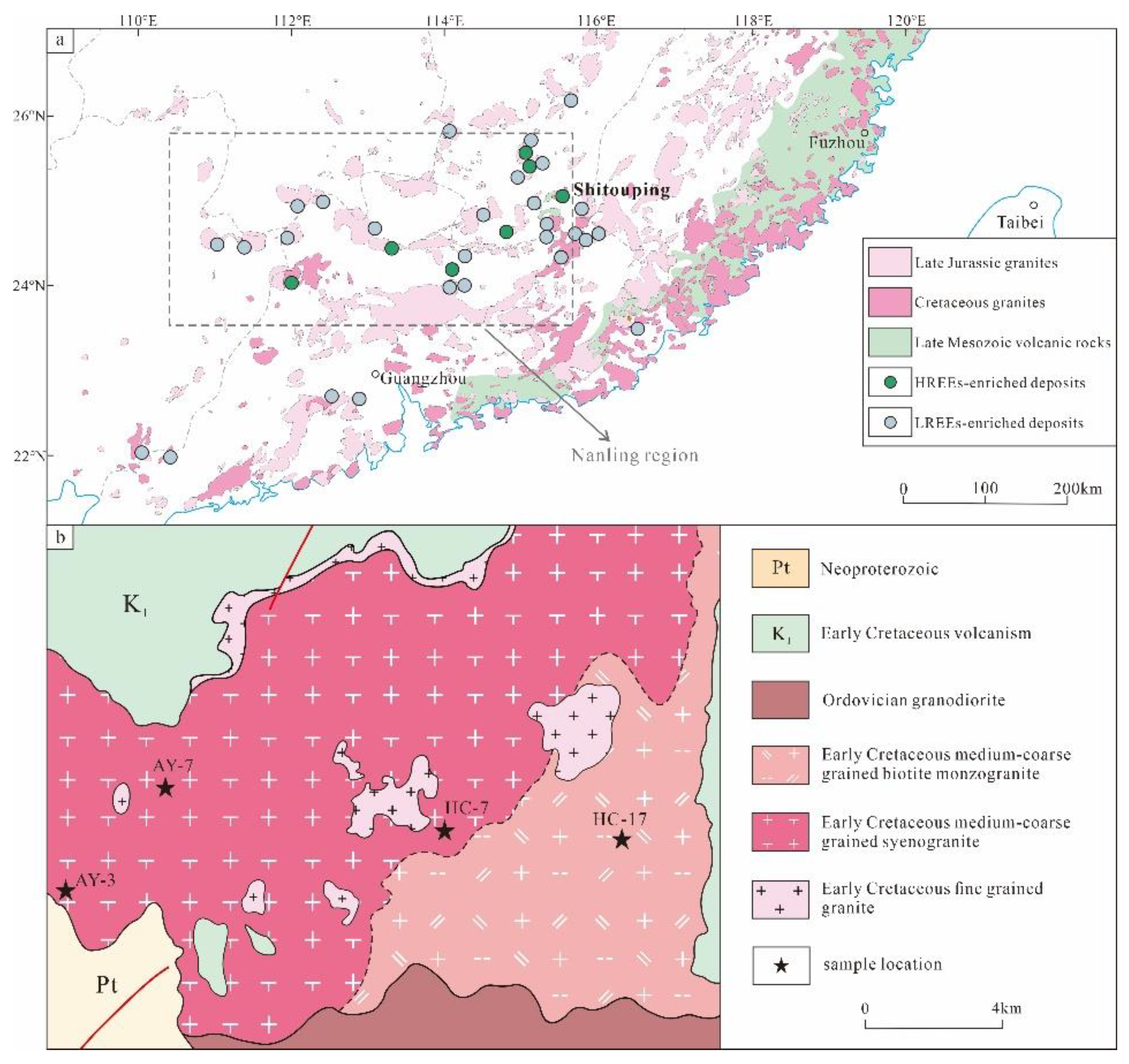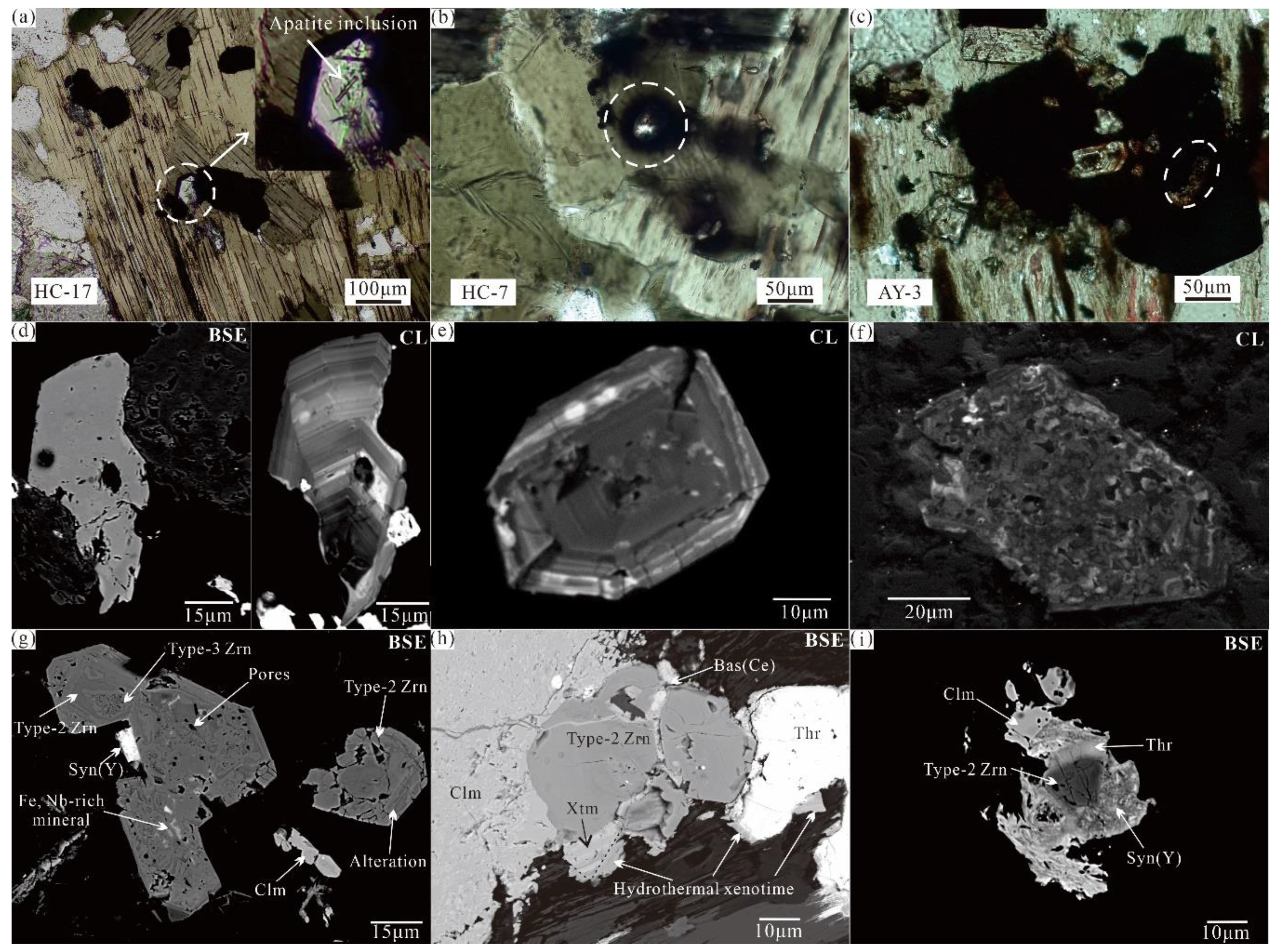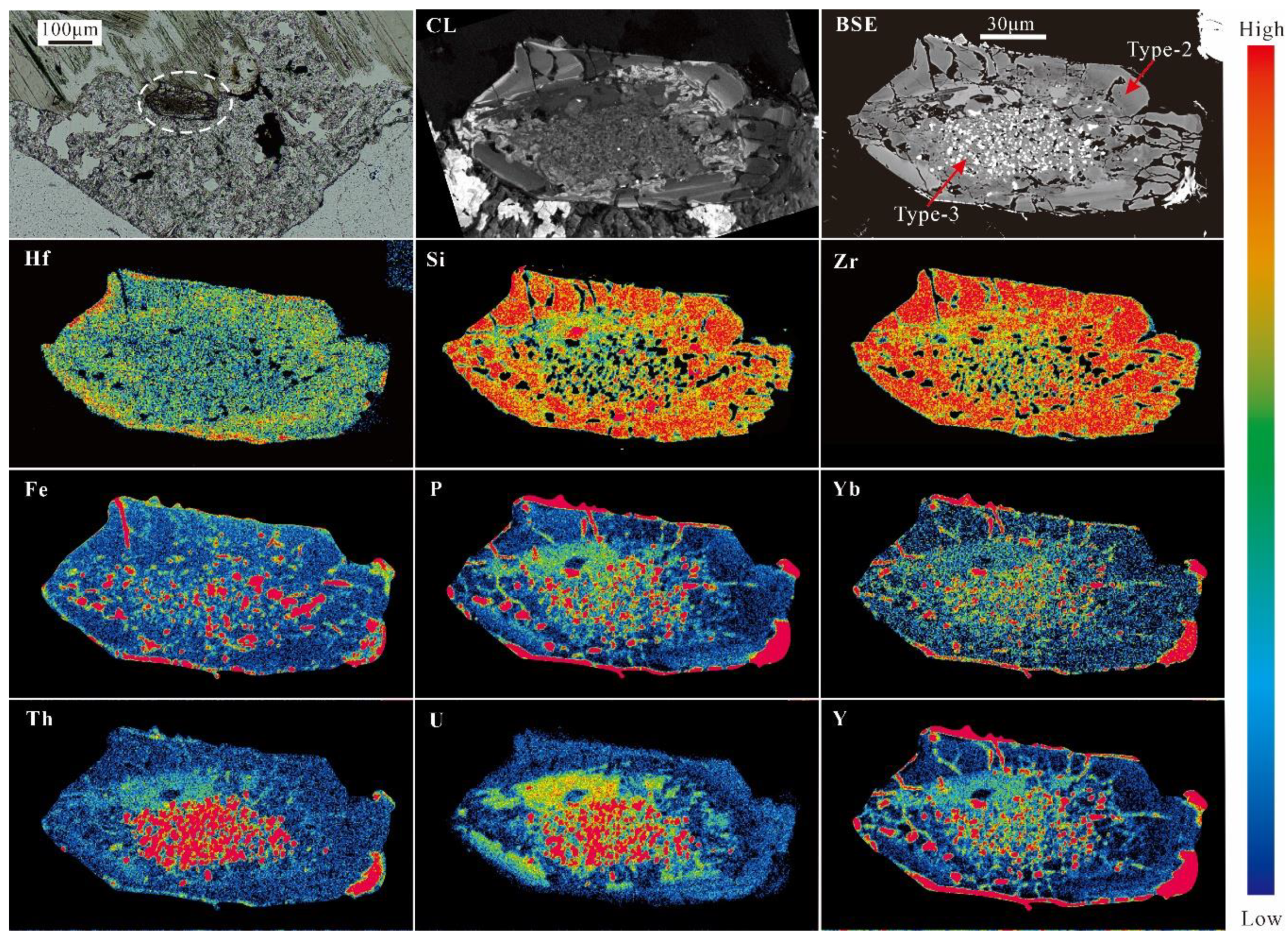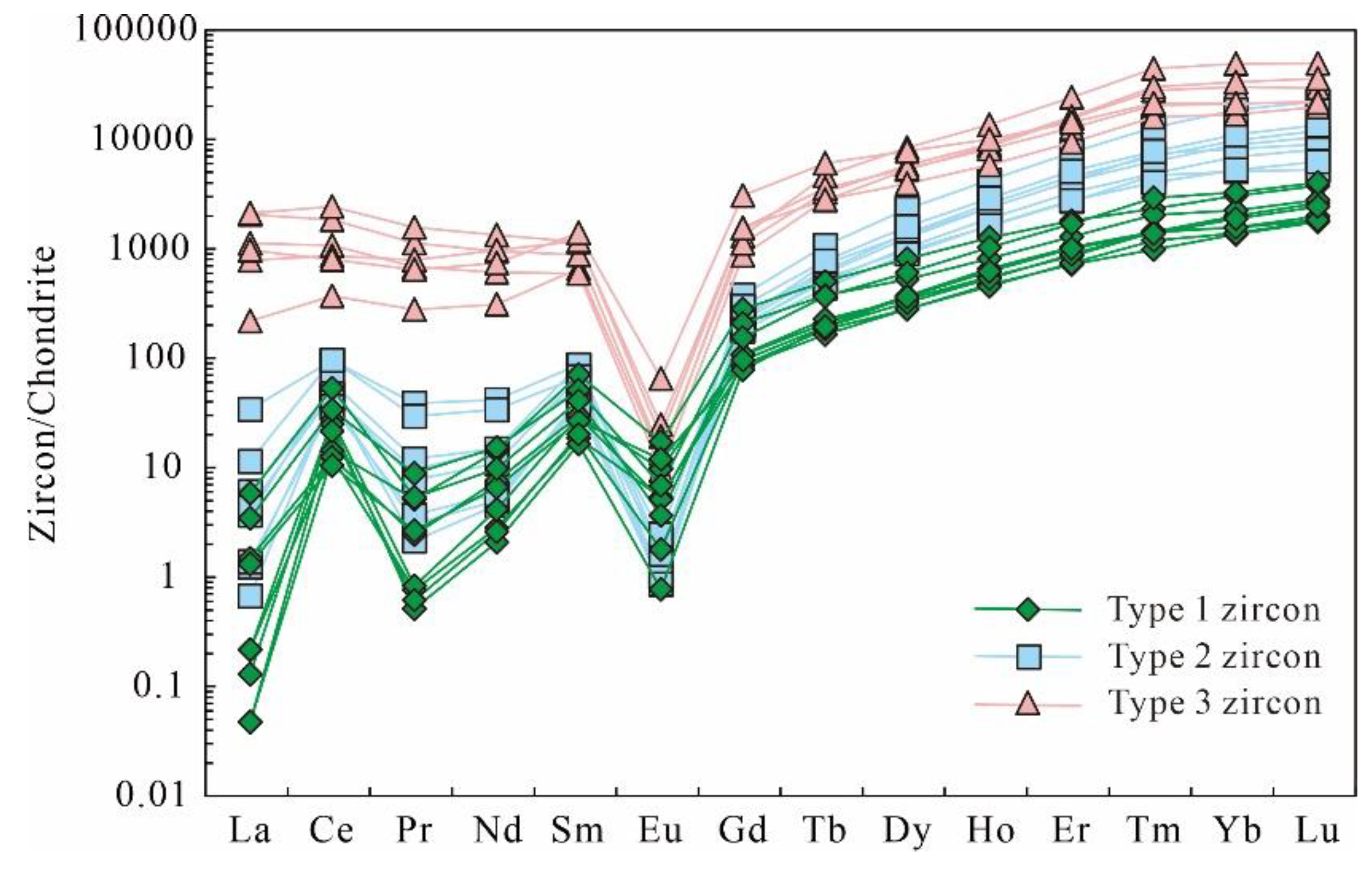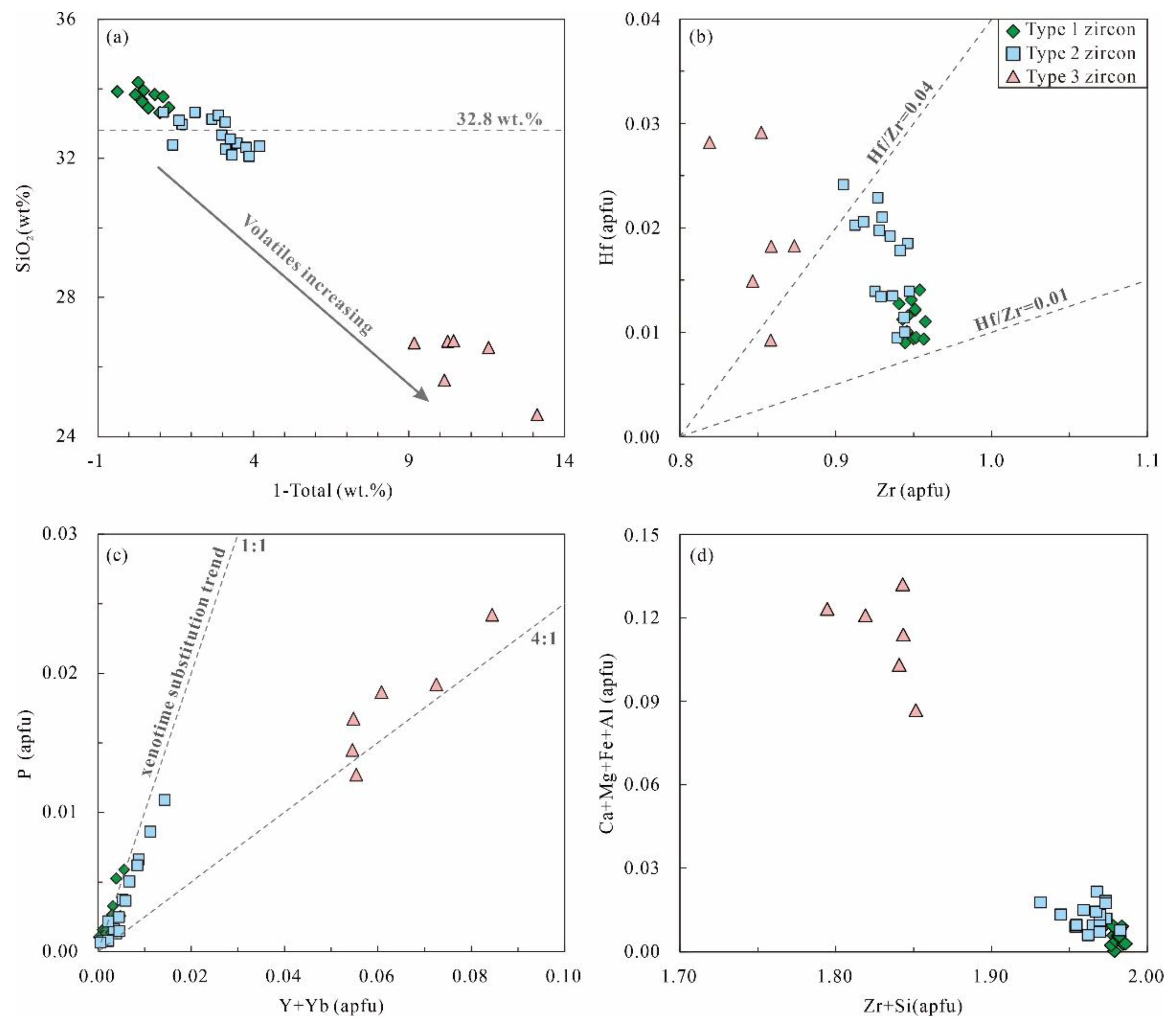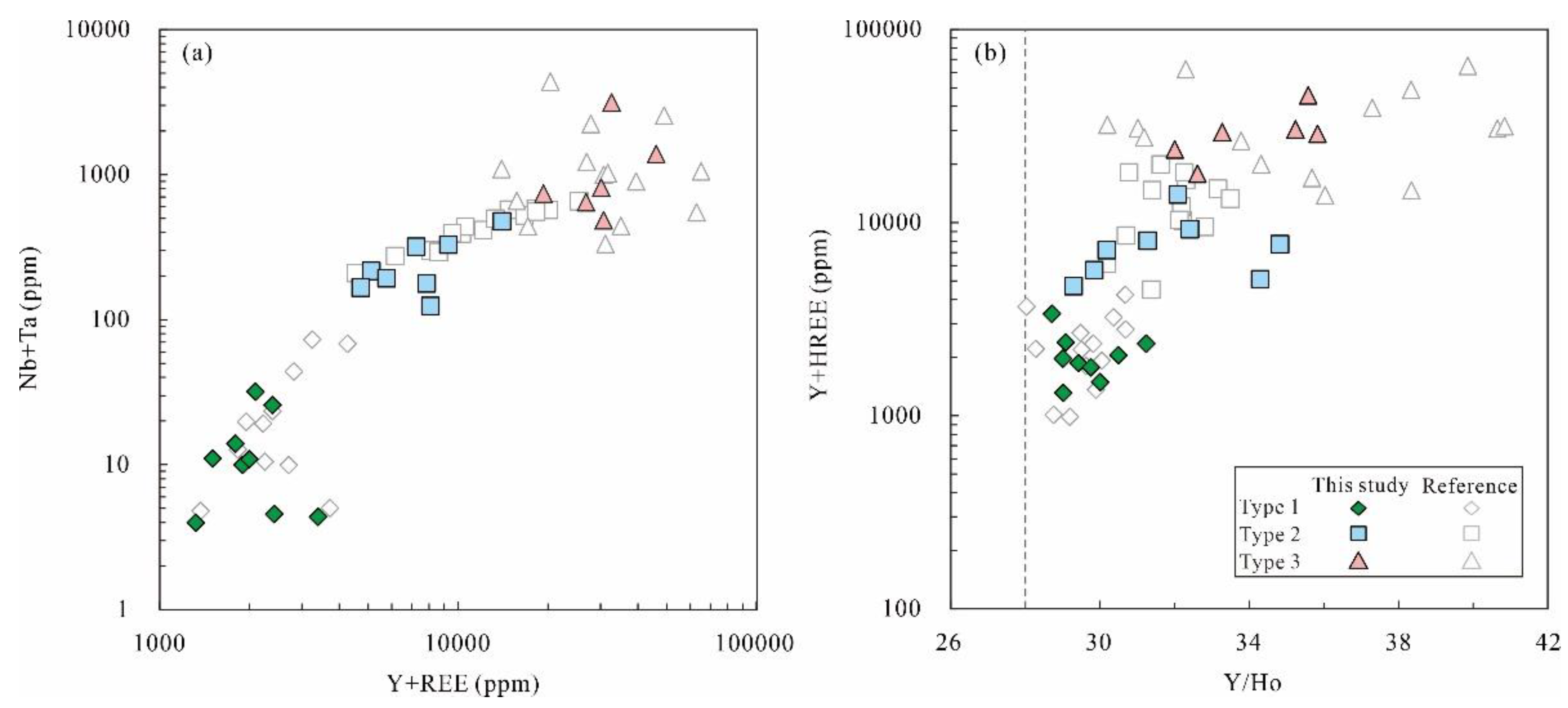1. Introduction
Rare earth elements (REE) are indispensable strategic resources in high-technology industries such as new energy, semiconductor materials and medicine [
1]. It is essential to clarify the genesis of heavy REE (HREEs: Gd-Lu + Y) deposits due to their low crustal abundance compared with light REEs (LREEs: La-Eu) [
2]. Ion-adsorptions HREE deposits are characterized by high HREE/LREE ratios and HREE contents in the weathering crusts of the granites [
3,
4]. Such deposits in South China and adjacent area provide almost all HREE resources in the world [
5]. It traditionally believed that the bedrocks of ion-adsorptions HREE deposits should be the HREE-type (LREE/HREE < 1) granites [
6,
7,
8], because of REE partitioning type of weathering crust having strong inheritance with the parent rock in most case. Recent studies, however, imply that ion-adsorption HREE deposits could also be formed by weathering of the LREE-type granitoid (LREEs/HREEs = 1–3) [
9,
10]. The HREEs further migrated and were enriched in the completely weathered zone of the weathering profiles, leading to the formation of an HREE deposit during the weathering process. Recent studies have shown that HREEs were previously enriched in both types of granitic bedrock during the magmatic-hydrothermal transition stage [
6,
7,
8,
9,
10,
11,
12,
13], and the accessory minerals crystallized during the early magmatic stage can serve as a record this enrichment process. For example, the variable texture and compositions of titanite from the LREE-type granitic bedrocks of the Gucheng deposit reflect the complex hydrothermal processes during the magmatic-hydrothermal transition stage and corresponding HREE accumulation in the alteration assemblages [
11].
Zircon is a common accessory mineral in the granites. Numerous studied have shown that the variable textures and compositions of zircon reflect the geophysical-geochemical evolution of the parental magma [
14,
15,
16,
17,
18,
19]. In addition, the prevailing belief is that hydrothermal fluids resulting from magma exsolution have the ability to induce zircon alteration and recrystallization, leading to formation of other accessory minerals during the hydrothermal stage [
20,
21,
22,
23,
24,
25,
26,
27,
28,
29]. In this case, zircon would retain the variable geochemical information of magma reservoir during the magmatic-hydrothermal transition [
30,
31,
32,
33]. Therefore, the texture and chemical compositions of zircon can be used to identify the REE migration and enrichment degree during the magmatic-hydrothermal process, thereby fingerprint identifying the mineralization process of REE deposits [
13,
18,
34].
The Shitouping pluton is located in the South China of which developed large-scale HREE deposits in its weathering crusts identified by recent geological surveys. Our recent researches of the petrology and geochemistry of the Shitouping granites have shown that the Early Cretaceous high-evolved syenogranite contain higher proportions of HREE minerals and total HREE contents compared with less-evolved homologous monzogranite [
10]. In order to further determine the relationship between magmatic evolution and HREE enrichment, comprehensive investigations have been carried out on zircon samples derived from both monzogranite and syenogranite in this study. Our results show that the diverse textures and compositions of zircons from syenogranites demonstrate the magmatic-hydrothermal evolution process and the corresponding mechanism for HREE pre-enrichment.
2. Geological background
The Shitouping deposit is located in the eastern part of Nanling tectono-magmatic zone of South China (
Figure 1a), which is also the world-class W-Sn-REE-Nb-Ta metallogenic region [
4]. The metallogenic mineralization is spatially associated with large volumes of Yanshanian (the late Middle Jurassic-Late Cretaceous) granitic rocks. More than 150 ion-adsorbed REE deposits have been discovered in this tectono-magmatic zone [
9], and almost all HREE deposits, such as the Zudong and Gucheng deposits [
1,
11], are hosted by weathering crusts of Yanshanian granitic rocks.
The Shitouping pluton is located in the southern part of Jiangxi Province and covers an area of about 200km
2 (
Figure 1b). These granites intruded the Late Neoproterozoic metamorphic sedimentary rocks, Ordovician weakly deformed biotite granodiorite [
35] and the earliest Cretaceous (145~143 Ma) silica volcanic rocks [
36,
37] during the Early Cretaceous (Ca. 140 Ma) [
10]. This pluton is mainly composed of medium- to coarse-grained biotite monzogranites and syenogranites with limited volume of fine-grained granite occurring as dyke or stock (
Figure 1b). The biotite monzogranites mainly consist of plagioclase, K-feldspar, quartz, biotite and minor Fe-Ti oxide mainly enclosed by biotite. Plagioclase (oligoclase) have clayey calcium-rich cores and fresh sodium-rich edges and trend to form clusters. The REE-bearing accessory minerals include zircon, apatite, monazite as well as a small amount of bastnäsite and synchysite-(Ce) associated with sericite. On the contrary, the syenogranites have lower proportions of plagioclase (albite), biotite, Fe-Ti oxide, apatite and monazite but higher proportions of hydrothermal HREE- and Nb-bearing minerals closely associated with fluorite [
10]. They are co-genetic with monzogranites showing identical Nd-Hf isotope compositions, and should be more evolved unit characterized by stronger Ba, Sr, P, Ti, and Eu negative anomalies (
Figure 2). Both two granites are LREE-type granites and the syenogranites containing abundant hydrothermal HREE-fluorocarbonates and higher total HREE contents should be the main bedrock of the large-scale Shitouping ion-adsorption HREE deposits [
10].
3. Analytical Methods
Three samples of syenogranites and one sample of monzogranites were collected for zircon internal structure and geochemical analyses, and the detailed sample location can be seen
Figure 1b. The crystals in microprobe slices were documented with reflected light micrographs as well as by backscattered electron (BSE) and cathodoluminescence (CL) images to expose their textures. The CL images were obtained using a Tescan MIRA3 LM instrument equipped with a CL detector at the Nanjing Hongchuang Geological Exploration Technology Service Co. Ltd (NHEXTS), Nanjing, China.
The major element compositions of zircon were determined by NHEXTS using a JEOL JXA-iSP100 Electron Probe Microanalyzer (EMPA). The accelerating voltage, beam current and diameter were 15 kV, 20 nA and 2~5 µm respectively. The peak counting time was 10 s for F, 20 s for Si and Zr, 40 s for Fe, P, Ca, and Al, 60 s for Ti, U, Y, Yb, Hf and Th, respectively. The background counting time was half of the peak on the high and low background positions. Standards used for data correction were diopside for Si, Ca and Mg, cubic zirconia for Zr, albite for Al, garnet for Y, apatite for P, uranium for U, thorium for Th, titanium oxide for Ti, hafnium for Hf, ytterbium of Yb, hematite for Fe, and rhodonite for Mn. All the data were corrected using ZAF correction method for the matrix effect. The accelerating voltage, beam current, pixel interval and dwell time of EPMA mapping of zircon were 15 kV, 50 nA, 0.5 μm and 50 ms respectively.
Zircon trace element analyses were undertaken at State Key Laboratory of Nuclear Resources and Environment, East China Institute of Technology, China, using the Agilent 7900 ICP-MS connected to a GeoLasHD laser ablation system (λ = 193 nm). All analyses were carried out with a beam diameter of 32 μm and a repetition rate of 5 Hz with an energy of 90 mJ. NIST SRM 610 and NIST SRM 612 glass [
38] were used as external standards.
4. Results
4.1. Zircon morphology and structure
Zircon in the Shitouping granites can be classified into three types (i.e., Type-1, Type-2 and Type-3) based on morphology and textures. Type-1 zircon grains showing euhedral prismatic crystals are commonly intergrown with magnetite and enclosed in biotite (
Figure 3a). They show needle apatite inclusion in transmitted-light microscopic image and chemically homogeneous interior in BSE images as well as well-developed multiple oscillatory growth zones in CL images (
Figure 3d).
Type-2 zircon grains are commonly enclosed with biotite. They are euhedral or subhedral crystals with slightly dusty appearance (
Figure 3b), and are without oscillatory growth zones in CL images (
Figure 3e). Some zircon grains show irregular zoning in BSE images with cusped edges and cataclasitc texture (
Figure 3g). They containing minor mineral inclusions are closely associated with hydrothermal Nb- and REE-bearing minerals (
Figure 3h, i).
Type-3 zircon grains are mainly intergrown with magnetite (
Figure 3c), and they display patchy, cloudy, or very irregular zoning in CL images (
Figure 3f and
Figure 4). They are closely associated with Type-2 zircon grains (
Figure 3g), and are heterogeneous with randomly distributed pores as well as thorite, xenotime and irregular hydrothermal Nb-bearing mineral inclusions under BSE.
4.2. Zircon compositions
Major and trace element compositions of the zircon samples are listed in
Supplementary Table S1 and S2, respectively. Three type zircons show distinct major and trace elements compositions. Type-1 zircon grains contain highest SiO
2 (33.32–34.18 wt%), ZrO
2 (62.88–64.26 wt%) contents and analytical totals (98.72–100.38 wt%), but lowest FeO, CaO, Na
2O, and Al
2O
3 contents below detection limit. They also have lowest total REE and Y contents, ranging from 552 to 1354 ppm and 772 to 2043 ppm, respectively. They show strongest positive Ce anomalies (Ce/Ce*= 7.01–92.3) in the chondrite-normalized REE patterns [
Figure 5]. Type-2 zircon grains show slightly lower SiO
2 (32.06–33.34 wt%) and ZrO
2 (58.51–62.52 wt%) contents but highest HfO
2 (1.07–2.67 wt%) contents. They have higher total REE contents compared with Type-1 zircon grains. They display strongest enrichment of HREEs compared to LREEs with LREE/HREE ratios ranging from 0.01 to 0.04. Type-3 zircon grains show significantly lower SiO
2 (22.97–29.48 wt%), ZrO
2 (41.39–53.19 wt%) contents and analytical totals (86.86–90.83 wt%), but highest FeO, CaO, Na
2O, and Al
2O
3 contents with detectable Yb
2O
3 (1.15-2.14 wt%) and F (0.71-1.16wt%). Moreover, they contain highest total REE (8518-18,651 ppm) and Y (10,794-27,433 ppm) contents but comparatively lower LREE/HREE ratios (0.03-0.32).
5. Discussion
5.1. Genesis of the zircons
Zircon showing variable texture and compositions could demonstrate the geophysical-geochemical evolution of the parental magma, and altered zircon would retain the chemical compositions of the volatile-rich fluids exsolved from highly fractionated granite [
40]. In this study, both three type zircon grains are closely associated with early crystalized minerals, and the chemical compositions of zircon could reveal the magmatic characteristic during its crystallization.
Type-1 zircons are mainly found in less evolved monzogranite. The observed magmatic textures, characterized by the presence of needle apatite inclusions and well-developed oscillatory zoning, suggest that these zircons crystallized from a primary cal-alkaline magma [
39]. Additionally, they exhibit consistently high SiO
2 and ZrO
2 contents, elevated ZrO
2/HfO
2 ratios, and significantly high EPMA analytical total contents (
Figure 6a,b;
Table S1), implying they crystallized from a volatile-undersaturated magma [
21]. Therefore, the Type-1 zircon grains should be the primary magmatic zircon crystalized during the early magmatic stage.
Type-2 zircon grains are predominantly found in highly evolved syenogranite. They exhibit a dark appearance without oscillatory growth zones in CL images and contain minor HREE-bearing mineral inclusions, which appear as white spots in BSE images (
Figure 3h). This is clearly distinct from Type-1 zircon grains that contain needle-shaped apatite inclusions. Some Type-2 zircon occurs as intergrowth within Type-1 zircon and displays a dark core with a bright rim in CL images (
Figure 3e), suggesting that Type-2 zircon likely originated from hydrothermal alteration of the Type-1 zircon. Furthermore, some Type-2 zircon grains are observed as intergrowth with secondary minerals, such as thorite and xenotime, which typically crystallized in the late stage of magmatic evolution in most cases (
Figure 3h). These zircon grains containing relatively low analytical totals (
Figure 6a) were generally considered as the result of radiation damage [
19,
21,
22], which is also consistent with higher U and Th contents compared with Type-1 zircon grains. Zircons characterized by high U-Th contents and coexistence with late-stage crystalline accessory minerals imply they are crystalized from residual melt in the late magmatic stage [
21,
25]. In some cases, cataclastic structure and amorphous domains at the edges of zircons can be observed due to exsolution of hydrothermal fluids, leading to irregular zoning patterns BSE images (
Figure 3g) [
18]. Moreover, Type-2 zircon grains contain higher incompatible element (e.g., Nb and Ta) contents than Type-1 zircon (
Figure 7a), which is also associated with late fluid influence. Therefore, it can be inferred that Type-2 zircon grains should have undergone crystallization from a residual melt with an enriched volatile composition during the later magmatic stage.
Type-3 zircon grains are closed associated with Type-2 zircon grains occurred in the syneogranites. They exhibit irregular zoning in BSE images and contain mineral inclusions similar to those found in the Type-2 zircon grains. However, the presence of abundant randomly distribute pores and hydrothermal irregular Fe, Nb-rich minerals within the Type-3 zircon grains imply that they had undergone intense hydrothermal alteration [
30,
31]. The paragenetic relationship between Type-2 and Type-3 zircon (
Figure 3g) and numerous thorite and coffinite inclusions in Type-3 zircon identified by major element mapping (
Figure 4) indicate that Type-3 zircon grains formed via a dissolution-reprecipitation process [
30,
31,
41,
42]. This process produces metamict zircon with pores and numerous hydrothermal mineral inclusions in most cases [
30], and typically occurs during the interaction between late-crystalized zircon and fluids. This is also in accordance with the findings of this study, which reveal that Type-3 zircon samples exhibiting lower analytical totals were typically associated with the presence of volatiles and H
2O within the zircon domains. [
41]. Furthermore, compared with other zircon grains, Type-3 zircon grains exhibit highest concentrations of total non-formula cations (
Table S1) as well as non-quadrivalent charge cations (
Figure 6d), such as Al
3+, Ca
2+ and Mg
2+, implying that these zircon grains were generated also by a diffusion-reaction process [
19,
29]. The evolutionary trend line between HREE (Y and Yb) and P of Type-3 zircon grains exhibits a distinct deviation from the coupled xenotime-type substitution trending line [
Figure 6c], implying the involvement of more intricate or multiple mechanisms for charge equilibrium within hydrothermal fluids [
29]. In addition, the logarithm of REE distribution coefficient between minerals and melts exhibits a simple parabolic relationship with the ion radius, which is considered as the crystal structure strain model [
46]. The Type-3 zircon grains have more elements that deviate from the simulated parabolic behavior compared with other zircon grains (
Figure 8), which can also serve as the result of the interaction between zircon and hydrothermal fluids. Therefore, it can be inferred that Type-3 zircon grains should generated by the intense hydrothermal alteration of Type-2 zircon in a volatile oversaturated environment.
5.2. Monitor the magmatic process
Magmatic-hydrothermal evolution processes are extensively existed in granitic bedrock of the ion-adsorptions HREE deposits in South China [
6,
7,
8,
9,
10,
11,
12,
13]. Fractionation of early crystalized LREE-rich minerals, such as apatite and monzonite, could result in the relative enrichment of HREE in the residual melt with lower LREEs/HREEs ratios. Our previous study has shown that the syenogranites should be the higher evolved granite characterized by lower proportions of secondary minerals as well as lower Zr/Hf, Nb/Ta and K/Rb ratios compared with monzogranites [
10]. This magmatic evolution process could also be traced by zircon. The monzogranites mainly contain well-developed oscillatory primary magmatic zircons representing an early-crystallized phase from less evolved magmatism. On the contrary, the syenogranites contain almost all late magmatic-hydrothermal zircons. Type-2 zircon grains containing relatively higher HfO
2 content compared with Type-1 zircon grains suggests that they are late-crystallized zircon during magmatic evolution (
Figure 6b) [
47,
48]. Furthermore, abundant hydrothermal Type-3 zircons with significant loss of the analysis totals and highest concentrations of total non-formula cations imply that syenogranites should be evolved phase undergone intense fluid metasomatism during the magmatic-hydrothermal process. [
19,
21]. In conclusion, the variable compositions from early magmatic to late hydrothermal metamict zircon in the Shitouping granites could reveal the magmatic evolution processes of this intrusion.
5.3. Fluids metasomatism recored by the zircon
Previous studies have shown that hydrothermal zircon compositions would retain the variable geochemical characteristic of exsolution fluid during the magmatic-hydrothermal transition [
23,
24,
25,
26,
27,
28,
29]. The syenogranites contain Type-3 zircon grains generated from a volatile oversaturated environment suggesting that they had undergone intense fluid metasomatism. The relatively high F content (0.71-1.16 wt%) in Type-3 zircon grains indicates a significantly elevated F concentration in the exsolution fluid from the highly-evolved granitic system. The presence of this phenomenon also serves as evidenced by the paragenetic relationship between zircon and fluorite [
10]. Fluorine can prolong magma fractional crystallization by reducing magma viscosity, forming fluoride complexes with incompatible elements (e.g., REE, U, Hf, Nb, Ta) that trigger the deposition of hydrothermal minerals during the late stages of magmatic evolution [
49,
50]. This is also consistent with the buck-rock geochemistry and mineral assemblages that abundant Nb-bearing minerals and hydrothermal HREE-fluorocarbonates closely associated with fluorite in syenogranites [
10]. The relative higher Y/Ho ratios in Type-3 zircon grains is also considered as the evidence of F-rich fluids metasomatism in most cases (
Figure 7b) [
22]. Moreover, the late magmatic fluids exhibit enrichment in HREEs but are not in a state of saturation, as evidenced by the hydrothermal HREE-bearing minerals presented as the edge of Type-2 zircon identified by EPMA mapping (
Figure 4). The positive correlation and increasing trend observed between Y/Ho ratios and HREE concentrations from early to late zircon grains suggest that post-magmatic fluids were gradual enrichment of HREEs during the magma differentiation. This is consistent with the hydrothermal xenotime occurring as the edges of thorite and magmatic xenotime (
Figure 3h). The highest HREE contents with detectable Yb
2O
3 in Type-3 zircon grains and the paragenetic relationship between Type-3 zircon and synchysite-(Y) (
Figure 3g) reveal that the exsolution of fluids enriched in HREEs plays a crucial role in promoting hydrothermal precipitation of HREE minerals. Previous studies have demonstrated that fluoride can be considered as an “adhesive” that promote REE-minerals deposition due to due to their strong complexation ability with REE ions [
51,
52]. Thus, we argue that the exsolution of HREE- and F-rich fluids during the magmatic-hydrothermal transition stage is the critical reason driving the migration and precipitation of HREEs and further HREEs mineralization in Shitouping deposit.
5.4. Implication for HREE mineralization in South China
The outcropping of a large number of granitic intrusions in South China can be attributed to the late Mesozoic subduction and retreat of the paleo-Pacific plate [
6,
7,
8,
9,
10,
11,
12,
13]. Although the granitic bedrocks of the newly discovered HREE deposits are predominantly LREE-type, their HREE contents exhibit significant enrichment in comparison to weakly evolved granite, such as the Shitouping pluton [
10]. The outcropping area of these LREE-type granites usually have significantly larger volume than that of the HREE-type granite due to the limited presence of residual highly differentiated melts during the magmatic process. Therefore, these LREE-type granites, which contain abundant hydrothermal HREE minerals, have the potential to be important sources of HREE resources in South China [
9].
It's should be noticed that only small proportion of Yanshannian granites develop HREE deposits in their weathering crusts, and granitic bedrocks of ion-adsorption HREE deposits were formed over a wide range of time periods, including the Late Jurassic formation of Dabu granite [
13], emplacement of Shitouping pluton in the Early Cretaceous [
10], and crystallization of Gucheng granite in the late stage of Early Cretaceous [
11]. Meanwhile, the highly evolved granite associated with W-Sn-Li polymetallic mineralization in the Nanling region is also predominantly concentrated during the Late Yanshanian [
57]. Such as the Mikengshan granite, in the eastern section of this investigated Shitouping pluton, exhibiting identical age and bulk-rock isotope compositions is closed associated with Sn mineralization rather than REE mineralization [
37]. The coexistence of polymetallic deposits with REE deposits suggests that the occurrence of REE mineralization is primarily independent of regional geological background and geodynamic processes. On the contrary, these bedrocks of ion-adsorption HREE deposits experienced intense HREE- and F-rich fluid metasomatism are the primary factors contributing to the pre-enrichment of HREE [
11,
13]. The accessory minerals that crystallized during the initial magmatic stage can provide compelling evidence for unveiling hydrothermal fluid metasomatism and subsequent HREE mineralization in granites.
6. Conclusion
Our study shows that zircons from the Shitouping monzogranites and syenogranites can be classified into three types based on textures and compositions. Type-1 zircon grains crystallized early in the granitic magma are well-developed oscillatory primary magmatic zircons, while Type-2 zircon grains are murky subhedral crystals crystallized from the residual melt. Anhedral Type-3 zircon grains showing distinctive amorphous textures with pores and numerous hydrothermal minerals should be the product of fluid metasomatism in a volatile oversaturated environment. The increasing of Y/Ho ratios from Type-1 to Type-3 zircon indicates that Shitouping granites underwent magmatic to hydrothermal evolutions. Syenogranites contain abundant hydrothermal Type-2 and Type-3 zircons compared with monzogranites indicating that they are more evolved phase undergone intense fluid metasomatism during the magmatic-hydrothermal process. Moreover, Type-3 zircon grains containing highest HREE contents reflects the exsolution of HREE-rich fluids during the magma evolution, which is important factor controlling HREE enrichment in Shitouping syenogranites and further generation of ion-adsorption HREE deposits.
Supplementary Materials
The following supporting information can be downloaded at the website of this paper posted on Preprints.org. Table S1: EPMA results of zircon from Shitouping granites. Table S2: LA-ICP-MS trace element results of zircon from Shitouping granites. Table S3: Trace element partition coefficients of the three types of zircon to host melt (whole-rock composition) and the ionic radii.
Author Contributions
L.G.: writing-original draft preparation, data curation and funding acquisition; X.W.: writing-review and editing; D.Z.: experimental testing; W.Z.: sampling; M.C.: writing-review, editing and software. All authors have read and agreed to the published version of the manuscript.
Funding
This research was funded by the Geological Exploration Project of Jiangxi province Finance (No. 20220014) and Science and Technology Innovation Project of Department of Natural Resources of Jiangxi province (No. ZRKJ20232526).
Data Availability Statement
Data presented was original and not inappropriately selected, manipulated, enhanced, or fabricated.
Acknowledgments
We would like to thank Fujun Zhong and Hongjie Ji from East China University of Technology and Haoran Dou from Nanjing Hongchuang Exploration Technology Service Co., Ltd for their assistance with the analyses. Two anonymous reviewers are thanked for their valuable comments and suggestions that improved this paper significantly.
Conflicts of Interest
The authors declare no conflict of interest.
References
- Fan, C.X.; Xu, C.; Shi, A.G.; Smith, M.P.; Kynicky, J.; Wei, C.W. Origin of heavy rare earth elements in highly fractionated peraluminous granites. Geochim. Cosmochim. Acta 2023, 343, 371–383. [Google Scholar] [CrossRef]
- Simandl, G.J. Geology and market-dependent significance of rare earth element resources. Miner. Deposita. 2014, 49, 889–904. [Google Scholar] [CrossRef]
- Li, M.Y.H.; Zhao, W.W.; Zhou, M.-F. Nature of parent rocks, mineralization styles and ore genesis of regolith-hosted REE deposits in South China: an integrated genetic model. J. Asian Earth Sci. 2017, 148, 65–95. [Google Scholar] [CrossRef]
- Li, Y.H.M.; Zhou, M.F.; Williams-Jones, A.E. The genesis of regolith-hosted heavy rare earth element deposits: insights from the world-class Zudong deposit in Jiangxi Province, South China. Econ. Geol. 2019, 114, 541–568. [Google Scholar] [CrossRef]
- Zhou, M.F.; Li, Y.H.M.; Wang, Z.C.; Li, X.C.; Liu, J.C. The genesis of regolith-hosted rare earth element and scandium deposits: Current understanding and outlook to future prospecting. Chin. Sci. Bull. 2020, 65, 3809–3824. (in Chinese). [Google Scholar] [CrossRef]
- Xu, C.; Kynický, J.; Smith, M.P.; Kopriva, A.; Brtnický, M.; Urubek, T.; Yang, Y.H.; Zhao, Z.; He, C.; Song, W.L. Origin of heavy rare Earth mineralization in South China. Nat. Commun. 2017, 8, 14598. [Google Scholar] [CrossRef]
- Feng, Y.Z.; Xiao, B.; Chu, G.B.; Li, S.S.; Wang, J. Late Mesozoic magmatism in the Gucheng district: Implication for REE metallogenesis in South China. Ore Geol. Rev. 2022, 148, 105034. [Google Scholar] [CrossRef]
- Zhao, X.; Li, N.B.; Huizenga, J. M.; Zhang, Q.B.; Yang, Y.Y.; Yan, S.; Yang, W.B.; Niu, H.C. Granitic magma evolution to magmatic-hydrothermal process vital to the generation of HREEs ion-adsorption deposits: Constraints from zircon texture, U-Pb geochronology, and geochemistry. Ore Geol. Rev. 2022, 146, 104931. [Google Scholar] [CrossRef]
- Zhao, Z.; Wang, D.H.; Bagas, L.; Chen, Z.Y. Geochemical and REE mineralogical characteristics of the Zhaibei Granite in Jiangxi Province, southern China, and a model for the genesis of ion-adsorption REE deposits. Ore Geol. Rev. 2022, 140, 104579. [Google Scholar] [CrossRef]
- Cao, M. X.; Wang, X. G.; Zhang, D. F.; Zhang, Y. F.; Gong, L. X.; Zhong, W. Petrogenesis and REE mineralogical characteristics of Shitouping granites in southern Jiangxi Province: Implication for HREE mineralization in South China. Ore. Geol. Rev. 2023, submitted.
- Feng, Y.Z.; Pan, Y.M.; Xiao, B.; Chu, G.B.; Chen, H.Y. Hydrothermal alteration of magmatic titanite: implication for REE remobilization and the formation of ion-adsorption HREE deposit, South China. Am. Mineral. 2023, in press. [Google Scholar]
- He, Y.L.; Ma, L.Y.; Li, X.R.; Wang, H.; Liang, X.L.; Zhu, J.X.; He, H.P. Mobilization and fractionation of rare earth elements during experimental bio-weathering of granites. Geochim. Cosmochim. Acta 2023, 343, 384–395. [Google Scholar] [CrossRef]
- Wang, H.; He, H.P.; Yang, W.B.; Bao, Z.W.; Liang, X.L.; Zhu, J.X.; Ma, L.Y.; Huang, Y.F. Zircon texture and composition fingerprint HREE enrichment in muscovite granite bedrock of the Dabu ion-adsorption REE deposit, South China. Chem. Geol. 2023, 616, 121231. [Google Scholar] [CrossRef]
- Belousova, E.A.; Griffin, W.L.; O’Reilly, S.Y. Zircon crystal morphology, trace element signatures and Hf isotope composition as a tool for petrogenetic modelling: examples from Eastern Australian Granitoids. J. Petrol. 2006, 47, 329–353. [Google Scholar] [CrossRef]
- Breiter, K.; Lamarao, C.N.; Borges, R.M.K.; Dall’Agnol, R. Chemical characteristics of zircon from A-type granites and comparison to zircon of S-type granites. Lithos, 2014, 192–195, 208–225. [Google Scholar] [CrossRef]
- Claiborne, L.L.; Miller, C.F.; Walker, B.A.; Wooden, J.L.; Mazdab, F.K.; Bea, F. Tracking magmatic processes through Zr/Hf ratios in rocks and Hf and Ti zoning in zircons: an example from the Spirit Mountain batholith, Nevada. Mineral. Mag. 2006, 70, 517–543. [Google Scholar] [CrossRef]
- Claiborne, L.L.; Miller, C.F.; Wooden, J.L. Trace element composition of igneous zircon: a thermal and compositional record of the accumulation and evolution of a large silicic batholith, Spirit Mountain, Nevada. Contrib. Mineral. Petrol. 2010, 160, 511–531. [Google Scholar] [CrossRef]
- Yang, W.B.; Niu, H.C.; Shan, Q.; Sun, W.D.; Zhang, H.; Li, N.B.; Jiang, Y.H.; Yu, X.Y. Geochemistry of magmatic and hydrothermal zircon from the highly evolved alkaline granite: implications for Zr-REE-Nb mineralization. Mineral. Deposita. 2014, 49, 451–470. [Google Scholar] [CrossRef]
- Zeng, L.J.; Niu, H.C.; Bao, Z.W.; Yang, W.B. Chemical lattice expansion of natural zircon during the magmatic-hydrothermal evolution of A-type granite. Am. Mineral. 2017, 102, 655–665. [Google Scholar] [CrossRef]
- Schaltegger, U.; Pettke, T.; Audetat, A.; Reusser, E.; Heinrich, C.A. Magmatic-to hydrothermal crystallization in the W–Sn mineralized Mole Granite (NSW, Australia) Part I: Crystallization of zircon and REE-phosphates over three million years-A geochemical and U–Pb geochronological study. Chem. Geol. 2005, 220, 215–235. [Google Scholar] [CrossRef]
- Erdmann, S.; Wodicka, N.; Jackson, S.E.; Corrigan, D. Zircon textures and composition: refractory recorders of magmatic volatile evolution? Contrib. Mineral. Petrol. 2013, 165, 45–71. [Google Scholar] [CrossRef]
- Qu, P.; Li, N.-B.; Niu, H.-C.; Yang, W.-B.; Shan, Q.; Zhang, Z.-Y. Zircon and apatite as tools to monitor the evolution of fractionated I-type granites from the central Great Xing’an Range, NE China. Lithos, 2019, 348-349, 105207. [Google Scholar] [CrossRef]
- Van Lichtervelde, M.; Melcher, F.; Wirth, R. Magmatic vs. hydrothermal origins for zircon associated with tantalum mineralization in the Tanco pegmatite, Manitoba, Canada. Am. Mineral. 2009, 94, 439–450. [Google Scholar] [CrossRef]
- Van Lichtervelde, M.; Holtz, F.; Dziony, W.; Ludwig, T.; Meyer, H.P. Incorporation mechanisms of Ta and Nb in zircon and implications for pegmatitic systems. Am. Mineral. 2011, 96, 1079–1089. [Google Scholar] [CrossRef]
- Wang, X.-L.; Coble, M.A.; Valley, J.W.; Shu, X.-J.; Kitajima, K.; Spicuzza, M.J.; Sun, T. Influence of radiation damage on Late Jurassic zircon from southern China: evidence from in situ measurements of oxygen isotopes, laser Raman, U–Pb ages, and trace elements. Chem. Geol. 2014, 389, 122–136. [Google Scholar] [CrossRef]
- Li, H.; Li, J.-W.; Algeo, T.J.; Wu, J.-H.; Cisse, M. Zircon indicators of fluid sources and ore genesis in a multi-stage hydrothermal system: the Dongping Au deposit in North China. Lithos, 2018, 314–315, 463–478. [Google Scholar] [CrossRef]
- Jiang, W.-C.; Li, H.; Turner, S.; Zhu, D.-P.; Wang, C. Timing and origin of multistage magmatism and related W–Mo–Pb–Zn–Fe–Cu mineralization in the Huangshaping deposit, South China: an integrated zircon study. Chem. Geol. 2020, 552, 119782. [Google Scholar] [CrossRef]
- Gardiner, N.J.; Hawkesworth, C.J.; Robb, L.J.; Mulder, J.A.; Wainwright, A.N.; Cawood, P.A. Metal anomalies in zircon as a record of granite-hosted mineralization. Chem. Geol. 2021, 585, 120580. [Google Scholar] [CrossRef]
- Zeng, Z.; Liu, Y. Magmatic–hydrothermal zircons in syenite: a record of Nb–Ta mineralization processes in the Emeishan large igneous province, SW China. Chem Geol. 2022, 589, 120675. [Google Scholar] [CrossRef]
- Geisler, T.; Schaltegger, U.; Tomaschek, F. Re-equilibration of zircon in aqueous fluids and melts. Elements, 2007, 3, 43–50. [Google Scholar] [CrossRef]
- Soman, A.; Geisler, T.; Tomaschek, F.; Grange, M.; Berndt, J. Alteration of crystalline zircon solid solutions: a case study on zircon from an alkaline pegmatite from Zomba–Malosa, Malawi. Contrib. Mineral. Petrol. 2010, 160, 909–930. [Google Scholar] [CrossRef]
- Han, J.; Chen, H.; Hollings, P.; Jiang, H.; Xu, H.; Zhang, L.; Xiao, B.; Xing, C.; Tan, Z. The formation of modified zircons in F-rich highly-evolved granites: an example from the Shuangji granites in Eastern Tianshan, China. Lithos, 2019, 324–325, 776–788. [Google Scholar] [CrossRef]
- Ersay, L.; Greenough, J.D.; Larson, K.P.; Dostal, J. Zircon reveals multistage, magmatic and hydrothermal rare earth element mineralization at Debert Lake, Nova Scotia, Canada. Ore Geol. Rev. 2022, 144, 104780. [Google Scholar] [CrossRef]
- Liu, Y.; Hou, Z.; Zhang, R.; Wang, P.; Gao, J.; Raschke, M.B. Zircon alteration as a proxy for rare earth element mineralization processes in carbonatite-nordmarkite complexes of the Mianning-Dechang rare earth element belt, China. Econ. Geol. 2019, 114, 719–744. [Google Scholar] [CrossRef]
- Yang, S.W.; Lou, F.S.; Zhang, F.R.; Ding, P.X.; Cao, Y.B.; Xu, Z.; Sun, C.; Feng, Z.H.; Ling, L.H. Anatexis-ceremonies magmatism activity of the Qishan granitic pluton in southern Jiangxi: chronological study of zircon U-Pb precise dating. Acta Geol. Sin. 2017, 91, 864–875. (In Chinese) [Google Scholar]
- Li, Q.; Zhao, K.D.; Lai, P.H.; Jiang, S.Y.; Chen, W. Petrogenesis of Cretaceous volcanic-intrusive complex from the giant Yanbei tin deposit, South China: Implication for multiple magma sources, tin mineralization, and geodynamic setting. Lithos, 2018, 296-299, 163–180. [Google Scholar] [CrossRef]
- Li, Q.; Zhao, K.D.; Palmer, M.R.; Chen, W.; Jiang, S.Y. Exploring volcanic-intrusive connections and chemical differentiation of high silica magmas in the Early Cretaceous Yanbei caldera complex hosting a giant tin deposit, Southeast China. Chem. Geol. 2021, 584, 120501. [Google Scholar] [CrossRef]
- Pearce, N.J.G.; Perkins, W.T.; Westgate, J.A.; Gorton, M.P.; Jackson, S.E.; Neal, C.R.; Chenery, S.P. A compilation of new and published major and trace element data for NIST SRM 610 and NIST SRM 612 glass reference materials. Geostand. Newslett. 1997, 21, 115–144. [Google Scholar] [CrossRef]
- Pupin, J. Zircon and granite petrology. Contrib. Mineral. Petrol. 1980, 73, 207–220. [Google Scholar] [CrossRef]
- Schaltegger, U. Hydrothermal zircon. Elements, 2007, 3, 51–79. [Google Scholar] [CrossRef]
- Nasdala, L.; Kronz, A.; Wirth, R.; Vaczi, T.; Perez-Soba, C.; Willner, A.; Kennedy, A.K. The phenomenon of deficient electron microprobe totals in radiation-damaged and altered zircon. Geochim. Cosmochim. Acta, 2009, 73, 1637–1650. [Google Scholar] [CrossRef]
- Tomaschek, F.; Kennedy, A.K.; Villa, I.M.; Lagos, M.; Ballhaus, C. Zircons from Syros, Cyclades, Greece–recrystallization and mobilization of zircon during high-pressure metamorphism. J. Petrol. 2003, 44, 1977–2002. [Google Scholar] [CrossRef]
- Hoskin, P.W.O.; Schaltegger, U. The composition of zircon and igneous and metamorphic petrogenesis. Rev. Mineral. Geochem. 2003, 53, 27–62. [Google Scholar] [CrossRef]
- Finch, R.J.; Hanchar, J.M. Structure and chemistry of zircon and zircon-group minerals. Rev. Mineral. Geochem. 2003, 53, 1–25. [Google Scholar] [CrossRef]
- Breiter, K.; Skoda, R. Vertical zonality of fractionated granite plutons reflected in zircon chemistry: the Cínovec A-type versus the Beauvoir S-type suite. Geol. Carpath. 2012, 63, 383–398. [Google Scholar] [CrossRef]
- Blundy, J.; Wood, B. Prediction of crystal-melt partition coefficients from elastic moduli. Nature, 1994, 372, 452–454. [Google Scholar] [CrossRef]
- Linnen, R.L.; Keppler, H. Melt composition control of Zr/Hf fractionation in magmatic processes. Geochim. Cosmochim. Acta, 2002, 66, 3293–3301. [Google Scholar] [CrossRef]
- Wang, X.; Griffin, W.L.; Chen, J. Hf contents and Zr/Hf ratios in granitic zircons. Geochem. J. 2010, 44, 65–72. [Google Scholar] [CrossRef]
- Bartels, A.; Behrens, H.; Holtz, F.; Schmidt, B.C.; Fechtelkord, M.; Knipping, J.; Crede, L.; Baasner, A.; Pukallus, N. The effect of fluorine, boron and phosphorus on the viscosity of pegmatite forming melts. Chem. Geol. 2013, 346, 184–198. [Google Scholar] [CrossRef]
- Vasyukova, O.; Williams-Jones, A.E. Fluoride–silicate melt immiscibility and its role in REE ore formation: evidence from the Strange Lake rare metal deposit, Quebec-Labrador, Canada. Geochim. Cosmochim. Acta, 2014, 139, 110–130. [Google Scholar] [CrossRef]
- Migdisov, A.A.; Williams-Jones, A.E. Hydrothermal transport and deposition of the rare earth elements by fluorine-bearing aqueous liquids. Mineral. Deposita. 2014, 49, 987–997. [Google Scholar] [CrossRef]
- Migdisov, A.A.; Williams-Jones, A.E.; Brugger, J.; Caporuscio, F.A. Hydrothermal transport, deposition, and fractionation of the REE: experimental data and thermodynamic calculations. Chem. Geol. 2016, 439, 13–42. [Google Scholar] [CrossRef]
- Louvel, M.; Etschmann, B.; Guan, Q.; Testemale, D.; Brugger, J. Carbonate complexation enhances hydrothermal transport of rare earth elements in alkaline fluids. Nat. Commun. 2022, 13, 1456. [Google Scholar] [CrossRef] [PubMed]
- Williams-Jones, A.E.; Migdisov, A.A.; Samson, L.M. Hydrothermal mobilization of the rare earth elements—a tale of “Ceria” and “Yttria”. Elements, 2012, 8, 355–360. [Google Scholar] [CrossRef]
- Sun, S.S.; McDonough, W.F. Chemical and isotopic systematics of oceanic basalts: implications for mantle composition and processes. Geol. Soc. Lond., Spec. Publ. 1989, 42, 313–345. [Google Scholar] [CrossRef]
- Bau, M. Controls on the fractionation of isovalent trace elements in magmatic and aqueous systems: evidence from Y/Ho, Zr/Hf, and lanthanide tetrad effect. Contrib. Mineral. Petrol. 1996, 123, 323–333. [Google Scholar] [CrossRef]
- Mao, J.W.; Cheng, Y.B.; Chen, M.H.; Franco, P. Major types and time–space distribution of Mesozoic ore deposits in South China and their geodynamic settings. Mineral. Deposita. 2013, 48, 267–294. [Google Scholar]
|
Disclaimer/Publisher’s Note: The statements, opinions and data contained in all publications are solely those of the individual author(s) and contributor(s) and not of MDPI and/or the editor(s). MDPI and/or the editor(s) disclaim responsibility for any injury to people or property resulting from any ideas, methods, instructions or products referred to in the content. |
© 2023 by the authors. Licensee MDPI, Basel, Switzerland. This article is an open access article distributed under the terms and conditions of the Creative Commons Attribution (CC BY) license (http://creativecommons.org/licenses/by/4.0/).
